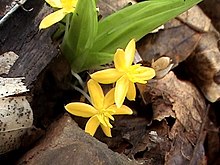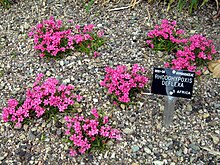Hypoxidaceae
| Hypoxidaceae | ||||||||||||
|---|---|---|---|---|---|---|---|---|---|---|---|---|

Daylily hypoxis ( Hypoxis hemerocallidea ) |
||||||||||||
| Systematics | ||||||||||||
|
||||||||||||
| Scientific name | ||||||||||||
| Hypoxidaceae | ||||||||||||
| R.Br. |
The Hypoxidaceae are a family in the order of the Asparagales . There are seven to nine genera with around 150 to 220 species. Some species and their varieties are used as ornamental plants in parks and gardens; little is known about further uses.
description
Habit and leaves
They are perennial herbaceous plants . Most of the species are geophytes and form rhizomes or tubers as persistence organs. They are seasonal green or, less often, evergreen.
The alternate and basal, often three lines arranged leaves can be stalked or sessile. The simple and entire leaf blades are folded to plicate. The leaf nerve is mostly parallel-veined, but in some species they form a pinnate-veined structure, but without interlinking side veins. In some species, some or all of the plant parts are more or less hairy with hairs of varying complexity.
Inflorescences and flowers
The flowers are terminally single or on inflorescence shafts in mostly assembled total inflorescences from racemose , spiked , capped or doldy partial inflorescences . There may be bracts.
The hermaphroditic flowers are radial symmetry and rarely two, mostly threefold. The free bracts are designed the same ( perigone ). Some taxa have only four bracts instead of six. The bloom bracts are white, yellow to orange or rarely red to pink. There are (rarely three) four or six fertile stamens per flower . In some taxa the stamens are fused with the bloom and / or with the stylus ( Curculigo ). The two-celled, sulcate pollen grains have an aperture. Three (or two) carpels are at a constant under (syncarp) ovary grown. There are one to three styluses available.
Fruits and seeds
There are a capsule fruits or berries (for example Curculigo ) is formed. In a few species, the capsule fruits open with teeth or pores. The seeds, which are brown to black due to phytomelans, have a rich oily endosperm .
Ingredients and chromosomes
Starch is stored. There are calcium oxalate crystals embedded as raphides. They contain flavonols.
The chromosomes are 2 to 5 µm long. The chromosome numbers are n = 6-9, 11.
Systematics and distribution
They occur in the Holarctic , Paleotropic , Neotropic , Capensis and Australis . They are widespread, there are just no species in Europe and northern Asia. A focus of biodiversity is in the subtropics and especially in southern Africa . Their areas range from the temperate latitudes to the tropics. The habitats range from arid to swampy areas.
The family was first published in 1814 under the name Hypoxideae by Robert Brown in A Voyage to Terra Australis , 2, p. 576. The type genus is Hypoxis L.
The genera were previously classified in the Liliaceae family or in a subfamily Hypoxidoideae of the Amaryllidaceae . But after molecular genetic studies, it turned out that they are not closely related to these two families.
The sister group of the Hypoxidaceae are the Asteliaceae , these two families are closely related to the Lanariaceae and together with the Blandfordiaceae form a monophyletic clade .
Cladogram for the closest related families within the order of the Asparagales according to the AP website:
|
|
|
|||||||||||||||||||||||||||||||||
|
|
In the Hypoxidaceae family there are seven to eight genera with around 150 to 220 species:
- Curculigo Gaertn. : The distribution area of the approximately 15 species lies in the subtropics to the tropics of the southern hemisphere .
- Empodium Salisb. : The seven or so species are floral elements of the Capensis .
- Hypoxidia F.Friedmann : The only two types come to the Seychelles before.
- Hypoxis L .: The wide range of the 80 to 100 species is in tropical and southern Africa (41 species), in the Neotropic to North America, in Southeast Asia and Australia .
- Molineria Colla : The eight or so species are distributed from tropical Asia to the Australian state of Queensland .
-
Neofriedmannia Kocyan & Wiland : The genus newly established in 2017 includes only one species:
- Neofriedmannia seychellensis (Bojer ex Baker) Kocyan & Wiland (Syn .: Curculigo seychellensis Bojer ex Baker ): It occurs in the Seychelles.
- Pauridia Harv. (Syn .: Syn. : Ianthe Salisb. . Illeg nom. Hypoxis subg. Ianthe (Salisb) Baker. , Hypoxis sect. Ianthe (Salisb) Benth.. , Spiloxene Salisb. , Saniella Hilliard & BLBurtt ): it contains since 2013 about 35 kinds mainly in southern Africa with the main focus in the Capensis and about five kinds in Australia.
- Rhodohypoxis Nel : The six species thrive in the summer rain areas of the Capensis.
-
Sinocurculigo Z.J.Liu, LJChen & K.Wei Liu : It was set up in 2012 with only one species:
- Sinocurculigo taishanica Z.J.Liu, LJChen & K.Wei Liu : It wasfirst describedin 2012 from the Chinese province of Guangdong .
use
Some species and their varieties are used as ornamental plants in parks and gardens. Little is known about any further use.
The tubers of Hypoxis hygrometrica can be eaten after they have been thoroughly cooked ( calcium oxalate crystals!).
Medical effects have been studied, but with no promising results.
The seeds of Hypoxis hygrometrica are hygrometric and are used by amateurs for weather forecasting.
swell
- The family of Hypoxidaceae in APWebsite. (engl.)
- Description of the Hypoxidaceae family in DELTA. (engl.)
- J. Wiland Szymanska & I. Nordal: Flora of tropical East Africa. , Hypoxidaceae , Kew: Royal Botanic Gardens, 2006, 25 pages. ISBN 1-84246-167-2
- DA Snijman: Hypoxidaceae. Cape plants. A conspectus of the Cape flora of South Africa (= Strelitzia. Volume 9). 2000, pp. 108-110.
- DA Snijman & Y. Singh: Hypoxidaceae. In: G. Germishuizen, NL Meyer: Plants of southern Africa: an annotated checklist (= Strelitzia. Volume 14). 2003, pp. 1071-1074.
- MH Grayum: Hypoxidaceae , Instituto Nacional de Biodiversidad, Costa Rica , 2007: Online. (span.)
- PG Richards: Hypoxidaceae in the New South Wales Flora : Online.
- Leslie Watson: Hypoxidaceae in the Western Australian Flora : Online.
Individual evidence
- ^ Hypoxidaceae in the Germplasm Resources Information Network (GRIN), USDA , ARS , National Genetic Resources Program. National Germplasm Resources Laboratory, Beltsville, Maryland.
- ↑ a b c d e f g h i j k Rafaël Govaerts (Ed.): Hypoxidaceae. In: World Checklist of Selected Plant Families (WCSP) - The Board of Trustees of the Royal Botanic Gardens, Kew . Retrieved July 22, 2018.
- ↑ a b Hypoxis hygrometrica at Plants for a Future.
- ^ Robert Hegnauer: Chemotaxonomie der Pflanzen : Hypoxidaceae in Volume 2, 1963, pp. 234-235 and in Volume 7, 1986, p. 661.




